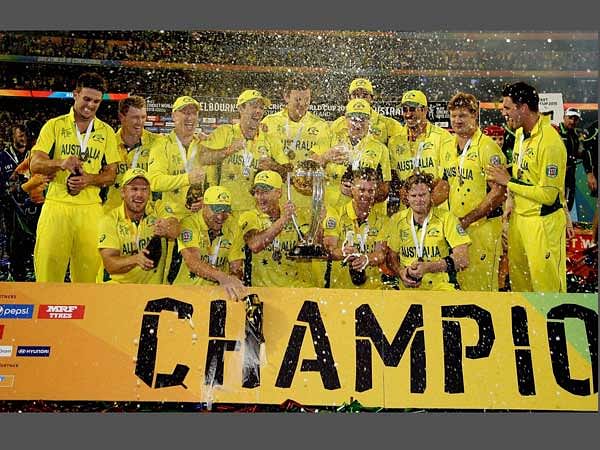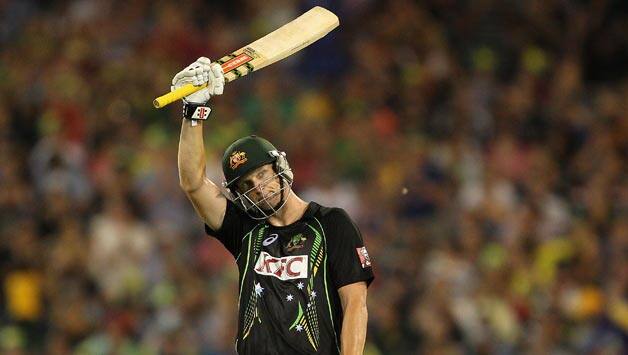
Are we in for another Australia dominated era?

Australia rampaged through to a record fifth World Cup win, becoming the second host nation after India to win the trophy. The Aussies lost just one game in the tournament, that too by the closest of margins. In fact, everytime they won a game, they won it quite convincingly.
They were particularly dominant in the knockout stages where they brushed past each of their opponents. Given the way the Aussies performed in the World Cup, one cannot help but wonder if another Australia dominated era has been ushered in.
The Australian squad that clinched the World Cup: Michael Clarke (c), George Bailey (vc), Pat Cummins, Xavier Doherty, James Faulkner, Aaron Finch, Brad Haddin, Josh Hazlewood, Mitchell Johnson, Mitchell Marsh, Glenn Maxwell, Steve Smith, Mitchell Starc, David Warner, Shane Watson.
The above squad contained only six players above the age of 30 - Brad Haddin (37), Shane Watson (33), Michael Clarke (33), Mitchell Johnson (33), Xavier Doherty (32) and George Bailey (32). The average age of the above squad barring Clarke and Haddin is just 27, which clearly means that a large chunk of these players will be around for some time.
Balance of aggression and composure in batting order
Australia have a very stable opening pair in Aaron Finch and David Warner. Both of these players have been very successful over the last couple of years. Moreover, they are both 28 years old, which means they have a lot of cricket left in them. At number 3, they have Steven Smith, easily one of the best batsmen in world cricket at present. The 25-year old was in stupendous form in the World Cup as he registered 5 consecutive scores in excess of 50. He is surely expected to be the lynchpin of Australia’s batting in years to come.
The retirement of Michael Clarke means that George Bailey could be a regular at no 4 given that he has a very good ODI record. Shane Watson is one player who has been moved up and down the order several times in his career. In the World Cup, he was moved to no 5 in order to accomodate an in-form Steve Smith in the top order. It is likely that the Baggie Greens will continue to use him at this position as he has a lot of experience and has the ability to play a patient innings as well as a swashbuckling one.
At 6, the Aussies have Glenn Maxwell, easily one of the most destructive batsmen in world cricket at present. In the matter of a few overs, he can completely take away the game from any opposition. Brad Haddin’s retirement means that his spot at no 7 could be taken by any of the fringe wicket keepers like Matthew Wade, Tim Paine and Peter Nevill. James Faulkner, one of the best all-rounders at present, comes in at 8. At 9 and 10, they have Mitchell Johnson and Mitchell Starc. While Johnson has a Test century to his name, Starc has a best score of 99.
The Aussies also have the option of using Mitchell Marsh at any of the lower order positions as he is more than handy with the bat. This batting depth not being enough, their batting lineup is pretty flexible too. Guys like Shane Watson, Glenn Maxwell and James Faulkner can all be moved up the order if there is a need to score some quick runs.
Fearsome pace attack hiding dearth of spinners
Australia’s new ball attack duties are shouldered by the deadly trio of Josh Hazlewood, Mitchell Johnson and Mitchell Starc. While this trio relies a lot on pace, James Faulkner has the ability to fox batsmen with the many variations that he has.
The Kangaroos also have Patrick Cummins in their ranks, another out and out fast bowler. However, even he needs to work a lot on his fitness. Mitchell Marsh and Shane Watson, the two all-rounders can both bowl at a brisk pace and chip in with a few overs.
While the pace department has no dearth of options, Xavier Doherty is the only frontline spinner in the Aussie squad. Given that he is above 30, the selectors may well go in for some younger spinning options like Ashton Agar, James Muirhead and Adam Zampa. Glenn Maxwell too is an option in the spin department.
The Fringe Players
The retirement of players like Clarke and Haddin would mean that some of the fringe players could get a chance to be part of the Australian team. In this aspect too, the Aussies have a lot of talent at their disposal. As far as the batting department is concerned, they have quite a few options like Cameron White, Nic Maddinson, Callum Ferguson and Travis Head.
Each of these players have a lot of time on their side and have either performed well on the international stage or in the Australian domestic circuit.

In the fast bowling department too, the Kangaroos have options aplenty. The likes of Nathan Coulter-Nile, James Pattinson, Kane Richardson and Gurinder Sandhu have shown what they are capable of.
Though Australia has excellent all-rounders like Shane Watson, Glenn Maxwell and James Faulkner, they have other options like Moises Henriques, Sean Abbott and Ashton Turner who can deliver with both bat and ball.
Captaincy
The retirement of Michael Clarke has vacated the post of Australia’s ODI captain. At present, George Bailey and Steven Smith seem to be the only contenders. However, given that Bailey is above 30 and he hasn’t been in great form over the last couple of years, the selectors might well go for Smith. The 25-year old has been in incredible form of over the last couple of years and was one of the major reasons for Australia’s title success and the rampaging run that preceded it.
What the numbers say
The below table contains the record of the top 8 ODI teams since 2013:
| Team | Played | Wins | Losses | Tie/NR | Win % | Home Wins, Win % | Away Wins, Win % |
|---|---|---|---|---|---|---|---|
| Australia | 54 | 35 | 14 | 5 | 64.81 | 25, 80.64 | 10, 43.47 |
| England | 57 | 23 | 33 | 1 | 40.35 | 8, 38.09 | 15, 41.67 |
| India | 70 | 43 | 22 | 5 | 61.42 | 16, 66.67 | 27, 58.69 |
| New Zealand | 53 | 30 | 18 | 5 | 56.60 | 21, 65.62 | 9, 42.85 |
| Pakistan | 59 | 26 | 31 | 2 | 44.06 | 6, 33.33 | 20, 48.78 |
| South Africa | 61 | 35 | 23 | 3 | 57.37 | 11, 57.89 | 24, 57.14 |
| Sri Lanka | 76 | 40 | 32 | 4 | 52.63 | 14, 58.33 | 26, 50 |
| West Indies | 48 | 20 | 26 | 2 | 41.67 | 11, 57.89 | 8, 27.58 |
N.B: ODI’s played by Pakistan in the UAE have been considered as their home games.
Looking at the table above, it is clear that Australia has the highest winning percentage in ODI’s played over the last couple of years. However, they owe this to their incredible record at home. On their home soil, the Aussies have won 25 of the 31 games played. In fact, they have won the most number of ODI’s at home and have the highest winning percentage at home.
However, if the away numbers are concerned the picture changes drastically. With 10 away wins, Australia are third from bottom. Also, their winning percentage is fourth from bottom as far as the top 8 teams are concerned.
In fact, Team India is the most successful ODI team both in terms of total number of wins and away wins. The Men in Blue also have the highest away win percentage in ODIs played since 2013. Teams like South Africa, Pakistan and Sri Lanka have a much better away record than Australia.
Adding to Australia’s many virtues, their coaching staff too consists of some shrewd cricketing minds like Darren Lehmann, Michael Di Venuto and Craig McDermott.
However, teams like India and South Africa can give them a run for their money. Both these teams have a good mix of youth and experience as part of their setup and have tormented Australia a lot in their heydays. ODI cricket is therefore in for a few very exciting years.